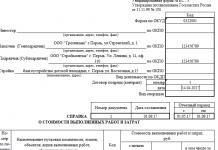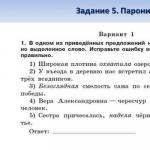The KS-2 form certificate is used for acceptance of completed construction and installation work by contractors. It reflects the cost of all work performed by the contractor at the current price level.
An act of form KS-2 is drawn up when the contractor has filled out the form for the act of completion of work and has completed all construction and installation work, and the customer does not have any claims against him. After the customer approves the work, the contractor, based on the data from this document, draws up a Certificate of the cost of work performed and expenses (form KS-3 act). After which the customer, based on this certificate, pays the contractor.
Certificate of acceptance of completed work, form KS-2: download form
Form KS-2 consists of a title part and a table.
Title part. The act of acceptance of completed work is two-sided: it is filled out by the contractor and the customer.
The “Investor” line is filled in as directed by the Customer. Therefore, even if an investor appears in the agreement, he does not sign this act.
In the lines “Customer (General Contractor)” and “Contractor (Subcontractor)” indicate the corresponding coordinates of the counterparties: name (full or abbreviated, but must be indicated), address, telephone and fax (indication is optional).
The types of activities of each counterparty can be taken into account in the corresponding details “according to OKPO”.
The line “Construction” indicates the general name of all construction projects that are provided for in the contract, as well as the address.
In the line “Object” only the name of the object on which the work is being carried out is indicated. If there are several of them (for example, a garage, a house), then in this line you should indicate exactly the object on which the corresponding work is being performed.
The relevant details of the “Contract” indicate its number and date of preparation.
Below, in the column “Certificate of Acceptance of Completed Work,” the details are filled in: the number of the document (act), its date of preparation and the reporting period for which it was compiled.
Also in the column “Estimated (contractual) cost in accordance with the contract (subcontract)” the estimated cost is noted, which corresponds to the specified cost in the contract.
Let's move on to the table.
The “Number” column is divided into two columns: 1-sequence number of works; 2-item numbering according to the estimate.
Column 3 “Name” contains the names of all stages of work, facilities, equipment, launch complexes, costs;
Column 4 indicates the number in the first column of SNIP (prices for all construction work).
If all prices for construction and repair work are indicated in the contract, then dashes are placed in columns 4 and 7.
Column 5 indicates the nomenclature (pcs. sq.m., etc.), except for %.
The “Work Completed” column has the following columns that are required to be filled out: 6 - the amount of physical volume of work performed in the appropriate units of measurement (see column 5); 7 - price per unit of work performed in rubles. according to SNIP; 8-cost of work performed (multiplying the corresponding cells of columns 6 and 7).
The cost of work performed is taken into account in KS-2 without VAT. Based on KS-2, form KS-3 is drawn up, these primary documents are filled out and considered as a whole. KS-3 confirms the cost of all work performed by the contractor.
The structure of the form is generally similar to KS-2, only the table has 6 columns and the amount of VAT and the amount of work performed including VAT are indicated separately.
We always indicate VAT. What exactly is the problem? Is it difficult to indicate an additional line in KS-2?
According to clause 12 of Order of the Ministry of Finance of Russia dated July 29, 1998 N 34n “On approval of the Regulations on accounting and financial reporting in the Russian Federation” (as amended on December 24, 2010), all business transactions carried out by the organization must be documented with supporting documents. These documents serve as primary accounting documents on the basis of which accounting is conducted.
When documenting work performed (services provided), an organization can use unified forms of acts or forms of acts developed independently and approved by accounting policies.
Thus, in capital construction, standard forms of primary documents approved by Resolution of the State Statistics Committee of Russia dated November 11, 1999 N 100 “On approval of unified forms of primary accounting documentation for accounting of work in capital construction and repair and construction work” can be used to document the work performed, namely the act on acceptance of work (form KS-2) and a certificate of the cost of work performed and expenses (form KS-3).
The procedure for applying tax deductions is regulated in Art. Art. 171 and 172 of the Tax Code of the Russian Federation.
We always write without thinking! But it's an interesting question. It would be interesting to hear the opinion of some accountant.
In accordance with paragraph 6 of Art. 171 of the Tax Code of the Russian Federation, tax amounts presented to the taxpayer by contracting organizations (customers-developers) when they carry out capital construction, assembly (installation) of fixed assets are subject to deductions. According to paragraph 5 of Art. 172 of the Tax Code of the Russian Federation, deductions of these tax amounts are made in the manner established by paragraph. 1 and 2 paragraphs 1 art. 172 of the Tax Code of the Russian Federation.
Clause 1 of Art. 172 of the Tax Code of the Russian Federation establishes that tax deductions are made on the basis of invoices issued by sellers when the taxpayer purchases goods (work, services), property rights, or on the basis of other documents in the cases provided for in paragraphs 3, 6 - 8 of Art. 171 Tax Code of the Russian Federation. Tax amounts presented to the taxpayer after registration of purchased goods (works, services), property rights are subject to deductions in the presence of relevant primary documents.
In accordance with paragraph 1 of Art. 168 of the Tax Code of the Russian Federation, when selling goods (work, services), transferring property rights, the seller, in addition to the price (tariff) of the goods (work, services) sold, transferred property rights, is obliged to present the corresponding amount of tax for payment to the buyer. According to paragraph 4 of Art. 168 of the Tax Code of the Russian Federation, the amount of tax must be highlighted as a separate line in settlement documents, primary accounting documents and invoices.
It should be noted that form KS-2 “Act of acceptance of completed work”, approved by Resolution of the State Statistics Committee of Russia dated November 11, 1999 N 100, does not provide for the allocation of the amount of VAT. For payments for work performed, the unified form KS-3 “Certificate of the cost of work performed and expenses”, approved by the same Resolution, is used.
At the same time, in the certificate of the cost of work performed and expenses (form KS-3), the line “Total” reflects the total amount of work and expenses excluding VAT, the amount of VAT is indicated on a separate line, the line “Total” indicates the cost of work performed and expenses, taking into account VAT. The certificate is used for settlements with the customer for work performed. One copy is drawn up for the contractor, the second - for the customer (developer, general contractor).
An act of form KS-2 is drawn up when the contractor has filled out the form for the act of completion of work and has completed all construction and installation work, and the customer does not have any claims against him. After the customer approves the work, the contractor, based on the data from this document, draws up a Certificate of the cost of work performed and expenses (form KS-3 act). After which the customer, based on this certificate, pays the contractor. Certificate of acceptance of completed work, form KS-2: form download Form KS-2 consists of a title part and a table. Title part. The act of acceptance of completed work is two-sided: it is filled out by the contractor and the customer. The “Investor” line is filled in as directed by the Customer. Therefore, even if an investor appears in the agreement, he does not sign this act.
Is it necessary to indicate VAT in KS-2
The customer asked each KS-2 to write down the VAT, which turns out to be a total amount that is 24 kopecks more than the signed SSR.
Question: can these 24 kopecks be removed somehow? or now just re-sign all the estimates and the contract? Thank you.
due to volumes or material prices.
Info
In general, this is not the case...when VAT is rounded up. this must be said to those who developed the MDS...
with idiotic (in my opinion) rounding rules veronika-2, please remind me about MDS..
VAT in ks-2 and ks-3
If I hire you, I will pay you 1,100,000 rubles, but the state will not return anything to me, since you are without VAT, so I will enter into an agreement with you for 1,000,000 rubles, so that the building will cost me 1,000,000 rubles. » That's the problem.
If it was possible to include VAT compensation in KS-3, then the state would compensate the customer for these costs.
And so it turns out that we buy materials with VAT and pay this VAT at the expense of our profits ((((Multi-million dollar contract, I don’t want to lose it! So I can’t understand why I can include VAT compensation in the estimate under the simplified tax system, but in the KS- 3 no.
Somehow it's not fair. abk63 Date: Thursday, 07/31/2014, 07:01 | Message # 22 Estimator Orenburg Awards: 358 Group: Verified City: Orenburg Messages: 17522 Reputation: 502 Status: Offline Quote Stesh () So I can’t understand why I can include VAT compensation in the estimate under the simplified tax system, but not in KS-3 .
Somehow it's not fair.
Is it necessary to indicate VAT in KS-3 if the individual entrepreneur is a defaulter?
The “Work Completed” column has the following required columns: 6 - the amount of physical volume of work performed in the appropriate units of measurement (see.
column 5) ;7 - price per unit of work performed in rubles. according to SNIP; 8-cost of work performed (multiplying the corresponding cells of columns 6 and 7).
Attention
The cost of work performed is taken into account in KS-2 without VAT.
Based on KS-2, form KS-3 is drawn up, these primary documents are filled out and considered as a whole.
KS-3 confirms the cost of all work performed by the contractor.
The contractor cooperates with an organization operating without VAT
KS-2, with 100% closure, does not agree with what was specified in the contract, determined on the basis of the Roksi SSR, we did the same with one customer in KS-2, VAT was not indicated. I have another stupid question in KS-3 when we closed another act but in another month the first closure goes down the line below? Rinara_sama, it is at the customer’s discretion whether to indicate all acts or everything in one line. For example, I demand in KS-3 a division only by projects (if there are several of them in the contract).
and if there is one project - one drain. =)
Added (08/12/2014, 1:30 pm) Rinara_sama, do you know why VAT is not required in KS-2? in Resolution 100 in standard forms in KS-2 there is no VAT, in KS-3 there is.
Based on this, my customers demand cleaning
VAT from KS-2 =) may be useful to someone, I’m confused by this question, whether VAT should be indicated in KS-2 or not.
VAT - 0.0. The inspectors write: Based on the data from Act KS-2, certificate KS-3 is filled out, while the primary accounting document - Act KS-2 contains mutually exclusive positions regarding VAT accounting.
The KS-3 certificate was not filled out in accordance with the KS-2 act in terms of accounting for the amount of VAT.
Thus, at the stage of concluding and executing a government contract, the structure of the formation of the contract price, which is its essential condition, was changed in terms of accounting for VAT in the government price.
contract.
How to indicate in KS2 from IP that there is no VAT
And do not hesitate to insert into the text the justification - letter number of the Russian Federation P/S/ usually we simply deliberately forget about VAT in NR and JV for small amounts... in order to save our nervous system... Then the design turns out to be quite readable and does not raise unnecessary questions.. And how “ more beautiful" to index? By cost items or at the end of the estimate? Added (03/13/2009, 08:05) The object is worth several million... It’s a pity to lose, but you don’t go over the limit for sleep? Yes, but if the account is in the millions... do everything according to the letter... indexing according to Art. cost always gives a large amount... compensation for NR and SP VAT - then according to the sections... I have a Grand. I set limited ones by sections. But VAT is not displayed by sections. Only the tail(((Framework contract. The price is established by the contract.
KS-2, a certificate of the cost of work performed and expenses in form No. KS-3, which indicates, among other things, the estimated (contractual) cost of work performed, their name and volume).
In this case, the contractor, in accordance with the rules for filling out an invoice used when calculating value added tax, the form of which is approved by Decree of the Government of the Russian Federation of December 26, 2011 N 1137, will have to issue an invoice with an entry in columns 7 and 8 : "Without VAT"." Post edited by av_00 - Tuesday, 06/30/2015, 12:16 Ramadan Date: Tuesday, 09/22/2015, 16:25 | Message # 29 Lieutenant Tyumen Awards: 0 Group: Verified City: Tyumen Messages: 75 Reputation: 0 Status: Offline Good afternoon! Help me deal with VAT.
So, in accordance with the State Statistics Committee of Russia dated November 11, 1999 No. 100, the allocation of VAT in the KS-2 form is not provided, while in the KS-3 form the total amount of work and costs without VAT is reflected in the “Total” line, VAT is indicated in a separate line, according to The “Total” line indicates the cost of work performed, including VAT. I’ve recently been working at a company - they assigned me to prepare a design report for a house under construction. We ourselves are both customers and contractors (investment and construction company). In the book, Nosenko came across this wording about the actual prices for basic materials that I charge according to invoices.
Dear colleagues, who has encountered such a situation? Do I understand correctly: in KS-2 I substitute actual prices for unaccounted basic materials without VAT, since VAT is taken on the total? Yes Cheryomukha, let’s not repeat ourselves. This one will self-destruct in a few minutes.
The estimate retained the line “including VAT” indicating the amount. Should VAT be reflected in forms KS-2 and KS-3?
On this issue we take the following position:
In such situations, it is advisable to create a new estimate when concluding a contract without taking into account VAT. In the case under consideration, there are no grounds for reflecting VAT amounts in forms KS-2 and KS-3. The contractor should enter dashes in the appropriate columns.
Justification for the position:
The contract based on the results of the electronic auction by virtue of the direct instructions of Part 10 of Art. 70 of the Federal Law of 04/05/2013 N 44-FZ "On goods, works, services for municipal needs" (hereinafter referred to as Law N 44-FZ) is concluded at the price proposed by the procurement participant with whom the contract is concluded based on the results of the relevant procedure ( regarding auctions, see also Part 4 of Article 68, Part 3 of Article 90 of Law No. 44-FZ). The same with regard to contracts concluded as a result of competitions, requests for proposals, follows from the provisions of paragraph 2 of Art. 42 of Law N 44-FZ, provisions on the evaluation of applications Art. 32 of Law No. 44-FZ, as well as clause 2, part 2, art. 51, part 2 art. 53, part 1 art. 54 and part 17 of Art. 83 Law No. 44-FZ.
By virtue of Part 2 of Art. 34, part 18 art. 34 and Art. 95 of Law N 44-FZ, when concluding and executing a contract, changing its terms (including the price condition) is not allowed, except in cases provided for by Art. 34, 95 of Law No. 44-FZ. Moreover, all the norms of Art. Art. 34, 95 of Law N 44-FZ, which allow a change in the contract price, allow such a change only by agreement of the parties. Thus, by virtue of the general principle, the contract price is determined by the proposal of the procurement participant with whom such a contract is concluded.
Law No. 44-FZ is based, among other things, on the norms of the Civil Code of the Russian Federation (Part 1 of Article 2 of this Law), which must be applied to relations regulated by Law No. 44-FZ, since otherwise is not provided for by the norms of this Law itself (see also answer to question No. 81 of the appendix to the letter of the Ministry of Economic Development of Russia dated September 30, 2014 No. D28I-1889). At the same time, neither the Civil Code of the Russian Federation nor Law No. 44-FZ determine the procedure for forming the price of an agreement (contract) depending on the taxation regime applied by the counterparty, and do not prescribe to indicate in the contract that the cost of goods, work or services is subject to value added tax ( VAT) is not subject to VAT or, on the contrary, is determined taking into account this tax. Presentation of VAT for payment (to the buyer) is an obligation provided for by tax legislation. Law N 44-FZ provides for only one case when a contract includes a mandatory condition on adjusting the amount payable in connection with the execution of the contract by the amount of tax payments associated with payment for the contract: such a condition is included in a contract concluded with an individual for with the exception of another person engaged in private practice (Part 13 of Article 34 of Law No. 44-FZ). Moreover, this requirement concerns precisely the amount of payments to an individual, and not the price of the contract, and follows precisely from the provisions of tax legislation obliging the organization - the source of payments to an individual to act as such a person (Article 226 of the Tax Code of the Russian Federation).
Accordingly, regardless of the taxation system applied by the counterparty, the customer does not have the right to demand a reduction in this price for the reason that the counterparty is exempt from the obligation to pay VAT in accordance with the Tax Code of the Russian Federation. This conclusion is confirmed by numerous explanations from government bodies: see, for example, pp. 8-11 letter of the Ministry of Economic Development of Russia dated September 30, 2014 N D28I-1889, paragraph 11 of letter of the Ministry of Economic Development of Russia dated March 17, 2015 N D28i-747, letter of the Ministry of Economic Development of Russia dated November 20, 2014 N D28-2549, dated October 31, 2014 N OG-D28 -8756, dated 07.11.2014 N D28i-2419, dated 12.12.2014 N D28i-2787, dated 23.12.2014 N D28i-2727, dated 18.12.2015 N D28i-3785, letters of the Ministry of Finance of Russia dated 29.08.2014 N 02-02 -09/43300, dated 09/05/2014 N 03-11-11/44793.
However, in the case where the terms of the notice of procurement, procurement documentation, draft contract provide for the formation of a price taking into account VAT, the question arises of determining the conditions for the price and procedure for executing the contract.
In our opinion, the indication in the text of the agreement (contract) that the contract price “includes VAT” or is set “excluding VAT” essentially only reflects the procedure for determining this price, determined taking into account the requirements of tax legislation. Moreover, as noted above, the requirements of tax legislation are mandatory in nature and cannot be canceled by agreement of the parties to the contract. In other words, the contract price proposed by the counterparty must be included in the text of the contract as established “including VAT” or “excluding VAT”, depending on whether this counterparty is in accordance with the rules of tax legislation or not. It also follows from this, in our opinion, that the mere indication in the contract that the price of work includes or does not include VAT is not essentially a condition of the contract, but only an indication of one of the components of the contract price, without affecting the amount this price and, even more so, on the counterparty’s obligation to pay VAT or its exemption from this obligation.
It should be noted that in practice this issue is resolved in different ways.
In a number of cases, courts come to the conclusion that if the draft contract, during the procurement, indicated that the cost of the work includes VAT, the contract must be concluded on appropriate terms (see, for example, the ruling of the Supreme Court of the Russian Federation dated June 26 .2015 N 306-KG15-7929, resolution of the AC of the North Caucasus District dated April 27, 2017 N F08-2458/17, resolution of the AC of the Central District dated June 17, 2016 N F10-1723/16).
Moreover, there are examples of courts recognizing as lawful the customer’s refusal to exclude the amount of VAT from the calculation of the contract price in the event of concluding a contract with a person exempt from paying this tax (see, for example, resolution of the Volga Region Autonomous District of April 17, 2017 N F06-19373/17, resolution AS of the North Caucasus District dated July 21, 2016 N F08-4781/16, resolution of the AS of the West Siberian District dated June 17, 2015 N F04-19591/15, resolution of the Nineteenth AAS dated April 13, 2016 N 19AP-571/16, see also resolution AS of the Far Eastern District dated December 21, 2016 N F03-5996/16).
At the same time, according to the position expressed in the letter of the Federal Tax Service dated November 8, 2016 N SD-4-3/21119@, if in the state contract for the supply of goods (work, services) their cost is indicated “including VAT” and upon payment of these goods (works, services), the customer has allocated the amount of VAT in the payment order; if an invoice is not issued to the seller applying the simplified taxation system, the obligation to pay VAT to the budget in accordance with the provisions of Chapter 21 of the Code does not arise (see also the letter of the Ministry of Finance of Russia dated November 18 .2014 N 03-07-14/58618). Moreover, if the parties agree on a contract price that includes VAT, the contractor does not pay this tax; it is possible that regulatory authorities may classify the actions of the customer as not requiring the counterparty to issue invoices (and, as a consequence, as shown above, to pay VAT) , as facilitating the receipt by a counterparty who does not pay VAT of unjust enrichment in the amount of the subject. Moreover, such qualification of the customer’s actions can be supported by the court (see, for example, the resolution of the Administrative Court of the North Caucasus District dated January 21, 2016 N F08-9711/15, the determination of the Supreme Arbitration Court of the Russian Federation dated 02/21/2012 N VAS-1045/12).
In the above situation, the contract includes a condition for payment of the price excluding VAT, but the estimate, which is an annex to the contract, contains an allocated amount of VAT. In this regard, it should be taken into account that under the contract on the basis of which work is carried out on the construction, reconstruction, overhaul of an enterprise, building, structure or other object, as well as installation, commissioning and other work inextricably linked with the object under construction (clause 2 of Art. 740 of the Civil Code of the Russian Federation), the contractor is obliged to carry out construction and related work in accordance with the technical documentation defining the volume, content of work and other requirements for them, and with an estimate determining the price of the work (clause 1 of Article 743 of the Civil Code of the Russian Federation) .
Thus, in this case, drawing up an estimate is mandatory and it is an integral part of the contract. In this regard, a situation arises when different parts of the contract provide for different procedures for pricing, and the indication mentioned in the question contained in the estimate does not correspond to the wording of the contract on the contract price. We cannot predict what position the court will take in such a situation, since it depends on judicial discretion. We believe that in the event of a dispute, the court will interpret the terms of the agreement according to the rules of Art. 431 Civil Code of the Russian Federation. Taking into account the information contained in the question, in our opinion, the only correct approach is that the indication of VAT in the estimate can only be considered as a technical error, since there are no grounds for claiming VAT in the above situation. This is due to the fact that, within the meaning of paragraph 3 of Art. 709, paragraph 2 of Art. 740, paragraph 1, art. 743 of the Civil Code of the Russian Federation, drawing up an estimate is only a way to determine the price, and an estimate is a document reflecting the formation of a price in the manner agreed upon by the parties. When carrying out a purchase, an estimate drawn up by the customer in accordance with Part 1, 9 of Art. 22 of Law N 44-FZ, only justifies the NMCC, the price of the contract with a single counterparty. The price of a contract concluded as a result of competitive procedures, as indicated above, is determined by the counterparty’s offer based on the results of the relevant procedure. Obviously, under such circumstances there is no reason to reflect VAT amounts in forms KS-2 and KS-3, where dashes can be entered in the corresponding columns.
For your information:
At the same time, since only the contractor can know all the nuances of the formation of the price he proposes, then the presentation of the estimate, that is, the calculation of this price, should be considered as his, first of all, responsibility. Of course, the estimate is subject to approval by the customer and comes into force after such approval, as provided for in paragraph 3 of Art. 709 of the Civil Code of the Russian Federation. In connection with the above, we note that if the estimate justifying the NMCC of construction work, in accordance with Part 9 of Art. 22 of Law N 44-FZ is drawn up in accordance with the methods and standards (state elemental estimate standards) for construction work and special construction work or in accordance with restoration norms and rules approved by federal authorities, then not a single provision of the law indicates that the contractor is obliged use these rates. Moreover, since according to paragraph 1 of Art. 424 of the Civil Code of the Russian Federation, prices (tariffs, rates, rates, etc.) established or regulated by authorized state bodies and (or) local government bodies are applied only in cases established by law, and prices for contract work are not regulated, law enforcement practice proceeds from the fact that estimate standards approved by various government bodies or institutions are not binding for private organizations (see, for example, resolution of the Federal Antimonopoly Service of the Moscow District dated September 18, 2008 N KG-A41/8488-08). There are also clarifications on this issue from regulatory authorities in relation to state and municipal contracts - letters from the Ministry of Regional Development of Russia dated 05/07/2008 N 11089-SM/08, Ministry of Economic Development of Russia dated 04/17/2008 N D05-1378. These clarifications were given during the period of validity of the Federal Law of July 21, 2005 N 94-FZ "On placing orders for the supply of goods, performance of work, provision of services for state and municipal needs", however, since the norms of Law N 44-FZ in this part are similar , and the norms of civil legislation in this part have not changed, we believe that they have not lost their relevance. Also, not a single provision of the law indicates that the estimate drawn up by the contractor must correspond to the estimate developed by the customer to justify the NMCC, in particular, this concerns the inclusion or non-inclusion of VAT in the price (see also, for example, paragraphs 8-11 of the letter of the Ministry of Economic Development of Russia from 09/30/2014 N D28I-1889).
Thus, in our opinion, in the described situation, the parties to the contract should agree on the preparation of a new estimate that does not include VAT, preferably by the contractor. We note that this procedure is not provided for by law, but is not prohibited either, so it is possible that the legality of such actions may be challenged by regulatory authorities. In this case, the issue can be finally resolved only by the court, taking into account the specific circumstances of the case and the wording of the contract and auction documentation.
Prepared answer:
Expert of the Legal Consulting Service GARANT
Alexandrov Alexey
The answer has passed quality control
The basis for payment by the customer for work performed is the KS-Z certificate. We tell you what the unified form KS-3 is and how to fill it out.
What is a KS-3 certificate
The unified form under OKUD number 0322001 “Certificate of the cost of work performed and expenses” is an integral part of the documentation for the acceptance by the customer organization of construction, installation and repair work performed by the contractor. Based on the certificate, final settlements are made between the customer and the contractor. The form is approved and regulated by Resolution of the State Statistics Committee of Russia No. 100 of November 11, 1999.
Upon completion of construction and installation work, as well as major repairs of buildings and structures, etc., the contractor provides the customer organization with the following package of documents:
The final cost value indicated in KS-3 must correspond to the total in the KS-2 act or several acts. The customer cannot fulfill his payment obligations to the contractor if he does not have a signed certificate.
A certificate is drawn up on the basis of the contract (government contract, agreement) and the KS-2 act in two copies, one copy for each of the parties. If a third party (investor) took part in the construction project, then upon request the contractor provides a document for it as well.
Form of the unified form KS-3
Form KS-3: sample filling in 2018
All data that is entered is directly related to the cost and expenses of the repairs, installation, construction, etc. performed. The certificate also includes costs not previously taken into account in the estimate documentation and contract, such as:
- an increase in wages for the contractor’s employees, which entailed an increase in contributions to extra-budgetary funds;
- increase in the cost of building materials;
- movement in the price level for rental of equipment and machinery involved in the performance of contract services;
- additional payments and allowances for hazardous working conditions and employment in the Far North;
- other unplanned expenses that adjusted the final cost.
Since the form is standardized and unified, the contractor does not have the right to make adjustments to it when filling it out, including changing the number of lines.
A certificate of the cost of work performed and expenses can be applied not only to the entire construction project, but also to its constituent parts. In this case, it is also necessary to indicate the full cost of the entire construction project.
Is VAT indicated in form KS-3? The customer requests no VAT line.
Fill out the title section.
In order to fill it out correctly, you first need to enter the data in the title part of the form:
- information about the customer, contractor and investor (if necessary) - full name and standard contact information;
- code from the all-Russian OKPO classifier;
- name and address of the construction site;
- details of the contract (agreement), which is the basis for the construction;
- current number and date of KS-3, as well as the reporting period during which construction was carried out (repair, installation, etc.).
Step 2. Fill out the table.
After completing the header, you must fill out the tabular part of the form in the following columns:
- Number in order.
- Detailed description of the type of work, object and specific stage, equipment, materials. If such a condition is provided for in the contract and design and estimate documentation, then it is possible to differentiate the work performed by the types of technical equipment used.
- Work type code (if available).
- Cumulative price.
- The cost determined by the contractor at the beginning of the reporting period (year).
- The total cost of the completed contract for the reporting period established by the contract.
At the end of the tabular part, values are entered in the “Total” lines - the final amount of construction (repair, installation) performed with allocated VAT at the rate established for the contractor in accordance with current legislation, as well as the cost including VAT.
Step 3. We certify the document.
At the end of the document, the signatures of the responsible persons from both the contractor and the customer are affixed, and the certificate itself is certified by the seals of the organizations.
Sample filling KS-3

Form KS-3. A certificate of the cost of work performed and expenses is a primary accounting document used to make payments between the contractor and the customer of construction work. The unified form of the form was approved by Resolution of the State Statistics Committee of the Russian Federation No. 100 dated November 11, 1999. Form code according to OKUD 0322001.
Filling out the certificate by construction organizations is due to the need to display the costs of construction and installation work in accounting. The basis for drawing up a certificate in form KS-3 is the data from the log of work performed in form KS-6. The cost of work in the certificate is displayed according to the prices previously agreed upon by the parties.
KS-3. Certificate of cost of work performed and expenses
The total cost of construction work includes:
- costs of carrying out this type of work, taking into account the increase in the cost of building materials used in their implementation;
- costs incurred as a result of the operation of various types of mechanisms, machines, and equipment;
- wage costs for employees performing this type of work;
- the amount of bonuses paid for work above the norm, in conditions dangerous to the health and life of the employee, etc.
The cost of work and the amount of costs for performing work in the KS-3 form is displayed both for the construction as a whole and for an individual facility (construction stage or start-up complex). In addition, costs are displayed for each individual type of equipment used in performing work, specifying the name and model of the equipment used. It is worth noting that this information is entered at the request of the customer. The main information displayed in the help is:
- names of all parties under the contract for construction work (customer, contractor, investor organization), their addresses and contact details;
- full address of the construction site;
- information about the contract (date of preparation and registration number);
- a list of construction and installation works that the contractor is obliged to perform according to the contract;
- the total amount of work and costs including and excluding VAT. It should be noted that the VAT amount is displayed on a separate line.
The certificate in form KS-3 is drawn up in a number of copies equal to the number of parties to the agreement. In most cases, the document is drawn up in two copies - one each for the customer and the performer of the work.
How can a contractor fill out KS-3 on his own?
Certificate of cost of work from costs form KS-3
Notes, certificates
A certificate of the cost of work performed and expenses, form KS-3, is an appendix to the act, form KS-2, which are filled out in relation to the delivery and acceptance of construction and installation work.
This certificate is an explanation of the acceptance certificate for completed work, form KS-2, with the help of which the contractor reports to the customer on completed construction or installation work.
Unified form No. KS-3 - form and sample
The certificate explains the costs incurred and indicates the detailed cost of the work.
The difference between the KS-3 certificate and the KS-2 certificate is that all amounts in the certificate are indicated including VAT. While in the act the amounts are written without taking into account tax.
The KS-3 form includes all costs incurred during the reporting period included in the estimate documentation, as well as related costs that were not taken into account anywhere in advance. The latter include increasing wages for employees, increasing purchase prices for building materials and other unforeseen expenses.
The contractor fills out the certificate of completed work KS-2 and the certificate for it KS-3 and provides it personally to the customer (if they work directly) or to the subcontractor.
If it is necessary to accept hidden work, then a hidden work report is drawn up.
We also offer to download the acceptance certificate for completed work.

Sample of filling out a certificate of cost of work, form KS-3
Instructions for filling out the KS-3 form:
Investor: details of the organization sponsoring the construction and installation work are filled in, the field is filled in if necessary and if there is an investor.
Customer: details of the organization that ordered the work.
Contractor: details of the organization that performed the construction or installation work.
Construction site: name and address of the facility where construction is taking place.
Contract agreement: number and date of this document.
Reporting Period: The time period for which the contractor reports.
The table provides a list of work performed and costs, indicating their name, cost from the beginning of the work, from the beginning of the year and in the reporting period.
As stated above, all amounts must include value added tax.
Based on the results of the table, the total amount spent is displayed, and the tax amount is also highlighted in a separate line.
Representatives of the customer and contractor sign the completed KS-3 certificate form, and also affix the seals of their organizations.


















